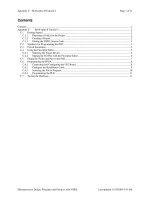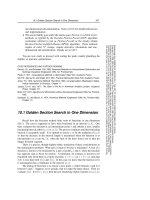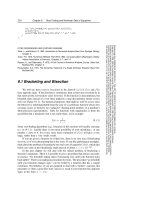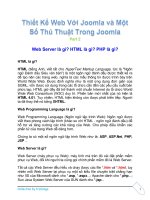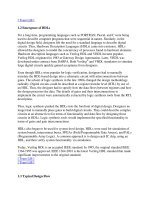Part 2: Security functional components docx
Bạn đang xem bản rút gọn của tài liệu. Xem và tải ngay bản đầy đủ của tài liệu tại đây (1.81 MB, 314 trang )
Common Criteria
for Information Technology
Security Evaluation
Part 2: Security functional components
September 2006
Version 3.1
Revision 1
CCMB-2006-09-002
Foreword
This version of the Common Criteria for Information Technology Security Evaluation (CC
v3.1) is the first major revision since being published as CC v2.3 in 2005.
CC v3.1 aims to: eliminate redundant evaluation activities; reduce/eliminate activities that
contribute little to the final assurance of a product; clarify CC terminology to reduce
misunderstanding; restructure and refocus the evaluation activities to those areas where
security assurance is gained; and add new CC requirements if needed.
CC version 3.1 consists of the following parts:
− Part 1: Introduction and general model
− Part 2: Security functional components
− Part 3: Security assurance components
Trademarks:
− UNIX is a registered trademark of The Open Group in the United States and other
countries
− Windows is a registered trademark of Microsoft Corporation in the United States
and other countries
Page 2 of 314 Version 3.1 September 2006
Legal Notice:
The governmental organisations listed below contributed to the development of this version
of the Common Criteria for Information Technology Security Evaluation. As the joint
holders of the copyright in the Common Criteria for Information Technology Security
Evaluation, version 3.1 Parts 1 through 3 (called “CC 3.1”), they hereby grant non-
exclusive license to ISO/IEC to use CC 3.1 in the continued development/maintenance of the
ISO/IEC 15408 international standard. However, these governmental organisations retain
the right to use, copy, distribute, translate or modify CC 3.1 as they see fit.
Australia/New Zealand: The Defence Signals Directorate and the
Government Communications Security Bureau respectively;
Canada: Communications Security Establishment;
France: Direction Centrale de la Sécurité des Systèmes d'Information;
Germany: Bundesamt für Sicherheit in der Informationstechnik;
Japan: Information Technology Promotion Agency
Netherlands: Netherlands National Communications Security Agency;
Spain: Ministerio de Administraciones Públicas and
Centro Criptológico Nacional;
United Kingdom: Communications-Electronics Security Group;
United States: The National Security Agency and the
National Institute of Standards and Technology.
September 2006 Version 3.1 Page 3 of 314
Table of contents
Table of Contents
1 INTRODUCTION 13
2 SCOPE 14
3 NORMATIVE REFERENCES 15
4 TERMS AND DEFINITIONS, SYMBOLS AND ABBREVIATED TERMS 16
5 OVERVIEW 17
5.1 17 Organisation of CC Part 2
6 FUNCTIONAL REQUIREMENTS PARADIGM 18
7 SECURITY FUNCTIONAL COMPONENTS 23
7.1 23 Overview
7.1.1 23 Class structure
7.1.2 24 Family structure
7.1.3 Component structure 25
7.2 27 Component catalogue
7.2.1 28 Component changes highlighting
8 CLASS FAU: SECURITY AUDIT 29
8.1 30 Security audit automatic response (FAU_ARP)
8.2 31 Security audit data generation (FAU_GEN)
8.3 33 Security audit analysis (FAU_SAA)
8.4 37 Security audit review (FAU_SAR)
8.5 39 Security audit event selection (FAU_SEL)
8.6 40 Security audit event storage (FAU_STG)
9 CLASS FCO: COMMUNICATION 43
9.1 44 Non-repudiation of origin (FCO_NRO)
9.2 46 Non-repudiation of receipt (FCO_NRR)
10 CLASS FCS: CRYPTOGRAPHIC SUPPORT 48
10.1 49 Cryptographic key management (FCS_CKM)
10.2 52 Cryptographic operation (FCS_COP)
Page 4 of 314 Version 3.1 September 2006
Table of contents
11 CLASS FDP: USER DATA PROTECTION 54
11.1 57 Access control policy (FDP_ACC)
11.2 59 Access control functions (FDP_ACF)
11.3 61 Data authentication (FDP_DAU)
11.4 63 Export from the TOE (FDP_ETC)
11.5 65 Information flow control policy (FDP_IFC)
11.6 67 Information flow control functions (FDP_IFF)
11.7 72 Import from outside of the TOE (FDP_ITC)
11.8 74 Internal TOE transfer (FDP_ITT)
11.9 77 Residual information protection (FDP_RIP)
11.10 79 Rollback (FDP_ROL)
11.11 81 Stored data integrity (FDP_SDI)
11.12 83 Inter-TSF user data confidentiality transfer protection (FDP_UCT)
11.13 84 Inter-TSF user data integrity transfer protection (FDP_UIT)
12 CLASS FIA: IDENTIFICATION AND AUTHENTICATION 87
12.1 89 Authentication failures (FIA_AFL)
12.2 91 User attribute definition (FIA_ATD)
12.3 92 Specification of secrets (FIA_SOS)
12.4 94 User authentication (FIA_UAU)
12.5 99 User identification (FIA_UID)
12.6 101 User-subject binding (FIA_USB)
13 CLASS FMT: SECURITY MANAGEMENT 103
13.1 105 Management of functions in TSF (FMT_MOF)
13.2 106 Management of security attributes (FMT_MSA)
13.3 109 Management of TSF data (FMT_MTD)
13.4 112 Revocation (FMT_REV)
13.5 113 Security attribute expiration (FMT_SAE)
13.6 114 Specification of Management Functions (FMT_SMF)
13.7 115 Security management roles (FMT_SMR)
September 2006 Version 3.1 Page 5 of 314
Table of contents
14 CLASS FPR: PRIVACY 117
14.1 118 Anonymity (FPR_ANO)
14.2 120 Pseudonymity (FPR_PSE)
14.3 122 Unlinkability (FPR_UNL)
14.4 123 Unobservability (FPR_UNO)
15 CLASS FPT: PROTECTION OF THE TSF 126
15.1 128 Underlying abstract machine test (FPT_AMT)
15.2 129 Fail secure (FPT_FLS)
15.3 130 Availability of exported TSF data (FPT_ITA)
15.4 131 Confidentiality of exported TSF data (FPT_ITC)
15.5 132 Integrity of exported TSF data (FPT_ITI)
15.6 134 Internal TOE TSF data transfer (FPT_ITT)
15.7 137 TSF physical protection (FPT_PHP)
15.8 140 Trusted recovery (FPT_RCV)
15.9 143 Replay detection (FPT_RPL)
15.10 144 State synchrony protocol (FPT_SSP)
15.11 146 Time stamps (FPT_STM)
15.12 147 Inter-TSF TSF data consistency (FPT_TDC)
15.13 148 Internal TOE TSF data replication consistency (FPT_TRC)
15.14 149 TSF self test (FPT_TST)
16 CLASS FRU: RESOURCE UTILISATION 151
16.1 152 Fault tolerance (FRU_FLT)
16.2 154 Priority of service (FRU_PRS)
16.3 156 Resource allocation (FRU_RSA)
17 CLASS FTA: TOE ACCESS 158
17.1 159 Limitation on scope of selectable attributes (FTA_LSA)
17.2 160 Limitation on multiple concurrent sessions (FTA_MCS)
17.3 162 Session locking (FTA_SSL)
17.4 165 TOE access banners (FTA_TAB)
Page 6 of 314 Version 3.1 September 2006
Table of contents
17.5 166 TOE access history (FTA_TAH)
17.6 167 TOE session establishment (FTA_TSE)
18 CLASS FTP: TRUSTED PATH/CHANNELS 168
18.1 169 Inter-TSF trusted channel (FTP_ITC)
18.2 171 Trusted path (FTP_TRP)
A SECURITY FUNCTIONAL REQUIREMENTS APPLICATION NOTES 173
A.1 173 Structure of the notes
A.1.1 173 Class structure
A.1.2 174 Family structure
A.1.3 174 Component structure
A.2 175 Dependency tables
B FUNCTIONAL CLASSES, FAMILIES, AND COMPONENTS 181
C CLASS FAU: SECURITY AUDIT 182
C.1 182 Audit requirements in a distributed environment
C.2 183 Security audit automatic response (FAU_ARP)
C.3 184 Security audit data generation (FAU_GEN)
C.4 187 Security audit analysis (FAU_SAA)
C.5 192 Security audit review (FAU_SAR)
C.6 194 Security audit event selection (FAU_SEL)
C.7 195 Security audit event storage (FAU_STG)
D CLASS FCO: COMMUNICATION 198
D.1 198 Non-repudiation of origin (FCO_NRO)
D.2 201 Non-repudiation of receipt (FCO_NRR)
E CLASS FCS: CRYPTOGRAPHIC SUPPORT 204
E.1 205 Cryptographic key management (FCS_CKM)
E.2 208 Cryptographic operation (FCS_COP)
F CLASS FDP: USER DATA PROTECTION 210
F.1 213 Access control policy (FDP_ACC)
F.2 216 Access control functions (FDP_ACF)
September 2006 Version 3.1 Page 7 of 314
Table of contents
F.3 218 Data authentication (FDP_DAU)
F.4 219 Export from the TOE (FDP_ETC)
F.5 221 Information flow control policy (FDP_IFC)
F.6 223 Information flow control functions (FDP_IFF)
F.7 229 Import from outside of the TOE (FDP_ITC)
F.8 231 Internal TOE transfer (FDP_ITT)
F.9 235 Residual information protection (FDP_RIP)
F.10 Rollback (FDP_ROL) 237
238 F.11 Stored data integrity (FDP_SDI)
239 F.12 Inter-TSF user data confidentiality transfer protection (FDP_UCT)
240 F.13 Inter-TSF user data integrity transfer protection (FDP_UIT)
G CLASS FIA: IDENTIFICATION AND AUTHENTICATION 243
G.1 244 Authentication failures (FIA_AFL)
G.2 246 User attribute definition (FIA_ATD)
G.3 247 Specification of secrets (FIA_SOS)
G.4 248 User authentication (FIA_UAU)
G.5 User identification (FIA_UID) 252
G.6 253 User-subject binding (FIA_USB)
H CLASS FMT: SECURITY MANAGEMENT 254
H.1 255 Management of functions in TSF (FMT_MOF)
H.2 257 Management of security attributes (FMT_MSA)
H.3 259 Management of TSF data (FMT_MTD)
H.4 261 Revocation (FMT_REV)
H.5 262 Security attribute expiration (FMT_SAE)
H.6 262 Specification of Management Functions (FMT_SMF)
H.7 263 Security management roles (FMT_SMR)
I CLASS FPR: PRIVACY 265
I.1 266 Anonymity (FPR_ANO)
I.2 268 Pseudonymity (FPR_PSE)
Page 8 of 314 Version 3.1 September 2006
Table of contents
I.3 273 Unlinkability (FPR_UNL)
I.4 275 Unobservability (FPR_UNO)
J CLASS FPT: PROTECTION OF THE TSF 279
J.1 281 Underlying abstract machine test (FPT_AMT)
J.2 283 Fail secure (FPT_FLS)
J.3 284 Availability of exported TSF data (FPT_ITA)
J.4 284 Confidentiality of exported TSF data (FPT_ITC)
J.5 285 Integrity of exported TSF data (FPT_ITI)
J.6 287 Internal TOE TSF data transfer (FPT_ITT)
J.7 288 TSF physical protection (FPT_PHP)
J.8 290 Trusted recovery (FPT_RCV)
J.9 294 Replay detection (FPT_RPL)
J.10 State synchrony protocol (FPT_SSP) 295
J.11 296 Time stamps (FPT_STM)
J.12 296 Inter-TSF TSF data consistency (FPT_TDC)
J.13 297 Internal TOE TSF data replication consistency (FPT_TRC)
J.14 298 TSF self test (FPT_TST)
K CLASS FRU: RESOURCE UTILISATION 300
K.1 300 Fault tolerance (FRU_FLT)
K.2 302 Priority of service (FRU_PRS)
K.3 303 Resource allocation (FRU_RSA)
L CLASS FTA: TOE ACCESS 306
L.1 307 Limitation on scope of selectable attributes (FTA_LSA)
L.2 308 Limitation on multiple concurrent sessions (FTA_MCS)
L.3 309 Session locking (FTA_SSL)
L.4 310 TOE access banners (FTA_TAB)
L.5 311 TOE access history (FTA_TAH)
L.6 311 TOE session establishment (FTA_TSE)
September 2006 Version 3.1 Page 9 of 314
Table of contents
M CLASS FTP: TRUSTED PATH/CHANNELS 313
M.1 313 Inter-TSF trusted channel (FTP_ITC)
M.2 314 Trusted path (FTP_TRP)
Page 10 of 314 Version 3.1 September 2006
List of figures
List of figures
Figure 1 - Relationship between user data and TSF data 21
Figure 2 - Relationship between “authentication data” and “secrets” 22
Figure 3 - Functional class structure 23
Figure 4 - Functional family structure 24
Figure 5 - Functional component structure 26
Figure 6 - Sample class decomposition diagram 28
Figure 7 - FAU: Security audit class decomposition 29
Figure 8 - FCO: Communication class decomposition 43
Figure 9 - FCS: Cryptographic support class decomposition 48
Figure 10 - FDP: User data protection class decomposition 56
Figure 11 - FIA: Identification and authentication class decomposition 88
Figure 12 - FMT: Security management class decomposition 104
Figure 13 - FPR: Privacy class decomposition 117
Figure 14 - FPT: Protection of the TSF class decomposition 127
Figure 15 - FRU: Resource utilisation class decomposition 151
Figure 16 - FTA: TOE access class decomposition 158
Figure 17 - FTP: Trusted path/channels class decomposition 168
Figure 18 - Functional class structure 173
Figure 19 - Functional family structure for application notes 174
Figure 20 - Functional component structure 175
Figure 21 - FAU: Security audit class decomposition 183
Figure 22 - FCO: Communication class decomposition 198
Figure 23 - FCS: Cryptographic support class decomposition 205
Figure 24 - FDP: User data protection class decomposition 213
Figure 25 - FIA: Identification and authentication class decomposition 244
Figure 26 - FMT: Security management class decomposition 255
Figure 27 - FPR: Privacy class decomposition 266
Figure 28 - FPT: Protection of the TSF class decomposition 281
Figure 29 - FRU: Resource utilisation class decomposition 300
Figure 30 - FTA: TOE access class decomposition 306
Figure 31 - FTP: Trusted path/channels class decomposition 313
September 2006 Version 3.1 Page 11 of 314
List of tables
List of tables
Table 1 Dependency table for Class FAU: Security audit 176
Table 2 Dependency table for Class FCO: Communication 176
Table 3 Dependency table for Class FCS: Cryptographic support 177
Table 4 Dependency table for Class FDP: User data protection 177
Table 5 Dependency table for Class FIA: Identification and authentication 178
Table 6 Dependency table for Class FMT: Security management 178
Table 7 Dependency table for Class FPR: Privacy 179
Table 8 Dependency table for Class FPT: Protection of the TSF 179
Table 9 Dependency table for Class FRU: Resource utilisation 180
Table 10 Dependency table for Class FTA: TOE access 180
Page 12 of 314 Version 3.1 September 2006
Introduction
1 Introduction
1 Security functional components, as defined in this CC Part 2, are the basis
for the security functional requirements expressed in a Protection Profile
(PP) or a Security Target (ST). These requirements describe the desired
security behaviour expected of a Target of Evaluation (TOE) and are
intended to meet the security objectives as stated in a PP or an ST. These
requirements describe security properties that users can detect by direct
interaction (i.e. inputs, outputs) with the IT or by the IT response to stimulus.
2 Security functional components express security requirements intended to
counter threats in the assumed operating environment of the TOE and/or
cover any identified organisational security policies and assumptions.
3 The audience for this CC Part 2 includes consumers, developers, and
evaluators of secure IT products. CC Part 1 Chapter 6 provides additional
information on the target audience of the CC, and on the use of the CC by the
groups that comprise the target audience. These groups may use this part of
the CC as follows:
• Consumers, who use this CC Part 2 when selecting components to
express functional requirements to satisfy the security objectives
expressed in a PP or ST. CC Part 1 Section 7 provides more detailed
information on the relationship between security objectives and
security requirements.
• Developers, who respond to actual or perceived consumer security
requirements in constructing a TOE, may find a standardised method
to understand those requirements in this part of the CC. They can also
use the contents of this part of the CC as a basis for further defining
the TOE security functionality and mechanisms that comply with
those requirements.
• Evaluators, who use the functional requirements defined in this part
of the CC in verifying that the TOE functional requirements
expressed in the PP or ST satisfy the IT security objectives and that
all dependencies are accounted for and shown to be satisfied.
Evaluators also should use this part of the CC to assist in determining
whether a given TOE satisfies stated requirements.
September 2006 Version 3.1 Page 13 of 314
Scope
2 Scope
4 This part of the CC defines the required structure and content of security
functional components for the purpose of security evaluation. It includes a
catalogue of functional components that will meet the common security
functionality requirements of many IT products.
Page 14 of 314 Version 3.1 September 2006
Normative references
3 Normative references
5 The following referenced documents are indispensable for the application of
this document. For dated references, only the edition cited applies. For
undated references, the latest edition of the referenced document (including
any amendments) applies.
CC Common Criteria for Information Technology Security Evaluation, Version
3.1, revision 1, September 2006. Part 1: Introduction and general model.
September 2006 Version 3.1 Page 15 of 314
Terms and definitions, symbols and abbreviated terms
4 Terms and definitions, symbols and
abbreviated terms
6 For the purposes of this document, the terms, definitions, symbols and
abbreviated terms given in CC Part 1 apply.
Page 16 of 314 Version 3.1 September 2006
Overview
5 Overview
7 The CC and the associated security functional requirements described herein
are not meant to be a definitive answer to all the problems of IT security.
Rather, the CC offers a set of well understood security functional
requirements that can be used to create trusted products reflecting the needs
of the market. These security functional requirements are presented as the
current state of the art in requirements specification and evaluation.
8 This part of the CC does not presume to include all possible security
functional requirements but rather contains those that are known and agreed
to be of value by the CC Part 2 authors at the time of release.
9 Since the understanding and needs of consumers may change, the functional
requirements in this part of the CC will need to be maintained. It is
envisioned that some PP/ST authors may have security needs not (yet)
covered by the functional requirement components in CC Part 2. In those
cases the PP/ST author may choose to consider using functional
requirements not taken from the CC (referred to as extensibility), as
explained in annexes A and B of CC Part 1.
5.1 Organisation of CC Part 2
10 Chapter 6 describes the paradigm used in the security functional
requirements of CC Part 2.
11 Chapter 7 introduces the catalogue of CC Part 2 functional components while
chapters 8 through 18 describe the functional classes.
12 Annex A provides explanatory information for potential users of the
functional components including a complete cross reference table of the
functional component dependencies.
13 Annex B through M provide the explanatory information for the functional
classes. This material must be seen as normative instructions on how to
apply relevant operations and select appropriate audit or documentation
information; the use of the auxiliary verb should means that the instruction is
strongly preferred, but others may be justifiable. Where different options are
given, the choice is left to the PP/ST author.
14 Those who author PPs or STs should refer to chapter 2 of CC Part 1 for
relevant structures, rules, and guidance:
• CC Part 1, chapter 4 defines the terms used in the CC.
• CC Part 1, annex A defines the structure for STs.
• CC Part 1, annex B defines the structure for PPs.
September 2006 Version 3.1 Page 17 of 314
Functional requirements paradigm
6 Functional requirements paradigm
15 This chapter describes the paradigm used in the security functional
requirements of this part of the CC. Key concepts discussed are highlighted
in bold/italics. This section is not intended to replace or supersede any of the
terms found in CC Part 1, chapter 4.
16 This part of the CC is a catalogue of security functional requirements that
can be specified for a Target of Evaluation (TOE). A TOE is a set of
software, firmware and/or hardware possibly accompanied by user and
administrator guidance documentation. A TOE may contain resources such
as electronic storage media (e.g. main memory, disk space), peripheral
devices (e.g. printers), and computing capacity (e.g. CPU time) that can be
used for processing and storing information and is the subject of an
evaluation.
17 TOE evaluation is concerned primarily with ensuring that a defined set of
security functional requirements (SFRs) is enforced over the TOE
resources. The SFRs define the rules by which the TOE governs access to
and use of its resources, and thus information and services controlled by the
TOE.
18 The SFRs may, in turn, include multiple Security Function Policies (SFPs).
Each SFP has a scope of control, that defines the subjects, objects, resources
or information, and operations controlled under the SFP. All SFPs are
implemented by the TSF (see below), whose mechanisms enforce the rules
defined in the SFRs and provide necessary capabilities.
19 Those portions of a TOE that must be relied on for the correct enforcement
of the SFRs are collectively referred to as the TOE Security Functionality
(TSF). The TSF consists of all hardware, software, and firmware of a TOE
that is either directly or indirectly relied upon for security enforcement.
20 The TOE may be a monolithic product containing hardware, firmware, and
software.
21 Alternatively a TOE may be a distributed product that consists internally of
multiple separated parts. Each of these parts of the TOE provides a particular
service for the TOE, and is connected to the other parts of the TOE through
an internal communication channel. This channel can be as small as a
processor bus, or may encompass a network internal to the TOE.
22 When the TOE consists of multiple parts, each part of the TOE may have its
own part of the TSF which exchanges user and TSF data over internal
communication channels with other parts of the TSF. This interaction is
called internal TOE transfer. In this case the separate parts of the TSF
abstractly form the composite TSF, which enforces the SFRs.
Page 18 of 314 Version 3.1 September 2006
Functional requirements paradigm
23 TOE interfaces may be localised to the particular TOE, or they may allow
interaction with other IT products over external communication channels.
These external interactions with other IT products may take two forms:
• The SFRs of the other “trusted IT product” and the SFRs of the TOE
have been administratively coordinated and the other trusted IT
product is assumed to enforce its SFRs correctly (e. g. by being
separately evaluated). Exchanges of information in this situation are
called inter-TSF transfers, as they are between the TSFs of distinct
trusted products.
• The other IT product may not be trusted, it may be called an
“untrusted IT product”. Therefore its SFRs are either unknown or
their implementation is not viewed as trustworthy. TSF mediated
exchanges of information in this situation are called transfers
outside of the TOE, as there is no TSF (or its policy characteristics
are unknown) on the other IT product.
24 The set of interfaces, whether interactive (man-machine interface) or
programmatic (application programming interface), through which resources
are accessed that are mediated by the TSF, or information is obtained from
the TSF, is referred to as the TSF Interface (TSFI). The TSFI defines the
boundaries of the TOE functionality that provide for the enforcement of the
SFRs.
25 Users are outside of the TOE. However, in order to request that services be
performed by the TOE that are subject to rules defined in the SFRs, users
interact with the TOE through the TSFI. There are two types of users of
interest to the CC Part 2 security functional requirements: human users and
external IT entities. Human users may further be differentiated as local
human users, meaning they interact directly with the TOE via TOE devices
(e.g. workstations), or remote human users, meaning they interact indirectly
with the TOE through another IT product.
26 A period of interaction between users and the TSF is referred to as a user
session. Establishment of user sessions can be controlled based on a variety
of considerations, for example: user authentication, time of day, method of
accessing the TOE, and number of allowed concurrent sessions (per user or
in total).
27 This part of the CC uses the term authorised to signify a user who possesses
the rights and/or privileges necessary to perform an operation. The term
authorised user, therefore, indicates that it is allowable for a user to perform
a specific operation or a set of operations as defined by the SFRs.
28 To express requirements that call for the separation of administrator duties,
the relevant CC Part 2 security functional components (from family
FMT_SMR) explicitly state that administrative roles are required. A role is a
pre-defined set of rules establishing the allowed interactions between a user
operating in that role and the TOE. A TOE may support the definition of any
September 2006 Version 3.1 Page 19 of 314
Functional requirements paradigm
number of roles. For example, roles related to the secure operation of a TOE
may include “Audit Administrator” and “User Accounts Administrator”.
29 TOEs contain resources that may be used for the processing and storing of
information. The primary goal of the TSF is the complete and correct
enforcement of the SFRs over the resources and information that the TOE
controls.
30 TOE resources can be structured and utilised in many different ways.
However, CC Part 2 makes a specific distinction that allows for the
specification of desired security properties. All entities that can be created
from resources can be characterised in one of two ways. The entities may be
active, meaning that they are the cause of actions that occur internal to the
TOE and cause operations to be performed on information. Alternatively, the
entities may be passive, meaning that they are either the container from
which information originates or to which information is stored.
31 Active entities in the TOE that perform operations on objects are referred to
as subjects. Several types of subjects may exist within a TOE:
• those acting on behalf of an authorised user (e.g. UNIX processes);
• those acting as a specific functional process that may in turn act on
behalf of multiple users (e.g. functions as might be found in
client/server architectures); or
• those acting as part of the TOE itself (e.g. processes not acting on
behalf of a user).
32 CC Part 2 addresses the enforcement of the SFRs over types of subjects as
those listed above.
33 Passive entities in the TOE that contain or receive information and upon
which subjects perform operations are called objects. In the case where a
subject (an active entity) is the target of an operation (e.g. interprocess
communication), a subject may also be acted on as an object.
34 Objects can contain information. This concept is required to specify
information flow control policies as addressed in the FDP class.
35 Users, subjects, information, objects, sessions and resources controlled by
rules in the SFRs may possess certain attributes that contain information
that is used by the TOE for its correct operation. Some attributes, such as file
names, may be intended to be informational or may be used to identify
individual resources while others, such as access control information, may
exist specifically for the enforcement of the SFRs. These latter attributes are
generally referred to as “security attributes”. The word attribute will be
used as a shorthand in some places of this part of the CC for the word
“security attribute”. However, no matter what the intended purpose of the
attribute information, it may be necessary to have controls on attributes as
dictated by the SFRs.
Page 20 of 314 Version 3.1 September 2006
Functional requirements paradigm
36 Data in a TOE is categorised as either user data or TSF data. Figure 1 depicts
this relationship. User Data is information stored in TOE resources that can
be operated upon by users in accordance with the SFRs and upon which the
TSF places no special meaning. For example, the content of an electronic
mail message is user data. TSF Data is information used by the TSF in
making decisions as required by the SFRs. TSF Data may be influenced by
users if allowed by the SFRs. Security attributes, authentication data, TSF
internal status variables used by the rules defined in the SFRs or used for the
protection of the TSF and access control list entries are examples of TSF
data.
37 There are several SFPs that apply to data protection such as access control
SFPs and information flow control SFPs. The mechanisms that implement
access control SFPs base their policy decisions on attributes of the users,
resources, subjects, objects, sessions, TSF status data and operations within
the scope of control. These attributes are used in the set of rules that govern
operations that subjects may perform on objects.
38 The mechanisms that implement information flow control SFPs base their
policy decisions on the attributes of the subjects and information within the
scope of control and the set of rules that govern the operations by subjects on
information. The attributes of the information, which may be associated with
the attributes of the container or may be derived from the data in the
container, stay with the information as it is processed by the TSF.
Figure 1 - Relationship between user data and TSF data
39 Two specific types of TSF data addressed by CC Part 2 can be, but are not
necessarily, the same. These are authentication data and secrets.
40 Authentication data is used to verify the claimed identity of a user requesting
services from a TOE. The most common form of authentication data is the
password, which depends on being kept secret in order to be an effective
security mechanism. However, not all forms of authentication data need to be
kept secret. Biometric authentication devices (e.g. fingerprint readers, retinal
scanners) do not rely on the fact that the data is kept secret, but rather that the
data is something that only one user possesses and that cannot be forged.
41 The term secrets, as used in CC Part 2 functional requirements, while
applicable to authentication data, is intended to also be applicable to other
types of data that must be kept secret in order to enforce a specific SFP. For
September 2006 Version 3.1 Page 21 of 314
Functional requirements paradigm
example, a trusted channel mechanism that relies on cryptography to
preserve the confidentiality of information being transmitted via the channel
can only be as strong as the method used to keep the cryptographic keys
secret from unauthorised disclosure.
42 Therefore, some, but not all, authentication data needs to be kept secret and
some, but not all, secrets are used as authentication data. Figure 2 shows this
relationship between secrets and authentication data. In the Figure the types
of data typically encountered in the authentication data and the secrets
sections are indicated.
Figure 2 - Relationship between “authentication data” and “secrets”
Page 22 of 314 Version 3.1 September 2006
Security functional components
7 Security functional components
7.1 Overview
43 This chapter defines the content and presentation of the functional
requirements of the CC, and provides guidance on the organisation of the
requirements for new components to be included in an ST. The functional
requirements are expressed in classes, families, and components.
7.1.1 Class structure
44 Figure 3 illustrates the functional class structure in diagrammatic form. Each
functional class includes a class name, class introduction, and one or more
functional families.
Figure 3 - Functional class structure
7.1.1.1 Class name
45 The class name section provides information necessary to identify and
categorise a functional class. Every functional class has a unique name. The
categorical information consists of a short name of three characters. The
short name of the class is used in the specification of the short names of the
families of that class.
7.1.1.2 Class introduction
46 The class introduction expresses the common intent or approach of those
families to satisfy security objectives. The definition of functional classes
does not reflect any formal taxonomy in the specification of the
requirements.
47 The class introduction provides a figure describing the families in this class
and the hierarchy of the components in each family, as explained in section
7.2.
September 2006 Version 3.1 Page 23 of 314
Security functional components
7.1.2 Family structure
48 Figure illustrates the functional family structure in diagrammatic form. 4
Figure 4 - Functional family structure
7.1.2.1 Family name
49 The family name section provides categorical and descriptive information
necessary to identify and categorise a functional family. Every functional
family has a unique name. The categorical information consists of a short
name of seven characters, with the first three identical to the short name of
the class followed by an underscore and the short name of the family as
follows XXX_YYY. The unique short form of the family name provides the
principal reference name for the components.
7.1.2.2 Family behaviour
50 The family behaviour is the narrative description of the functional family
stating its security objective and a general description of the functional
requirements. These are described in greater detail below:
• The security objectives of the family address a security problem that
may be solved with the help of a TOE that incorporates a component
of this family;
• The description of the functional requirements summarises all the
requirements that are included in the component(s). The description
is aimed at authors of PPs, STs and functional packages who wish to
assess whether the family is relevant to their specific requirements.
7.1.2.3 Component levelling
51 Functional families contain one or more components, any one of which can
be selected for inclusion in PPs, STs and functional packages. The goal of
this section is to provide information to users in selecting an appropriate
functional component once the family has been identified as being a
necessary or useful part of their security requirements.
Page 24 of 314 Version 3.1 September 2006
Security functional components
52 This section of the functional family description describes the components
available, and their rationale. The exact details of the components are
contained within each component.
53 The relationships between components within a functional family may or
may not be hierarchical. A component is hierarchical to another if it offers
more security.
54 As explained in 7.2 the descriptions of the families provide a graphical
overview of the hierarchy of the components in a family.
7.1.2.4 Management
55 The management requirements contain information for the PP/ST authors to
consider as management activities for a given component. The management
requirements are detailed in components of the management class (FMT).
56 A PP/ST author may select the indicated management requirements or may
include other management requirements not listed. As such the information
should be considered informative.
7.1.2.5 Audit
57 The audit requirements contain auditable events for the PP/ST authors to
select, if requirements from the class FAU: Security audit, are included in the
PP/ST. These requirements include security relevant events in terms of the
various levels of detail supported by the components of the Security audit
data generation (FAU_GEN) family. For example, an audit note might
include actions that are in terms of: Minimal - successful use of the security
mechanism; Basic - any use of the security mechanism as well as relevant
information regarding the security attributes involved; Detailed - any
configuration changes made to the mechanism, including the actual
configuration values before and after the change.
58 It should be observed that the categorisation of auditable events is
hierarchical. For example, when Basic Audit Generation is desired, all
auditable events identified as being both Minimal and Basic should be
included in the PP/ST through the use of the appropriate assignment
operation, except when the higher level event simply provides more detail
than the lower level event. When Detailed Audit Generation is desired, all
identified auditable events (Minimal, Basic and Detailed) should be included
in the PP/ST.
59 In the class FAU: Security audit the rules governing the audit are explained
in more detail.
7.1.3 Component structure
60 Figure illustrates the functional component structure. 5
September 2006 Version 3.1 Page 25 of 314

